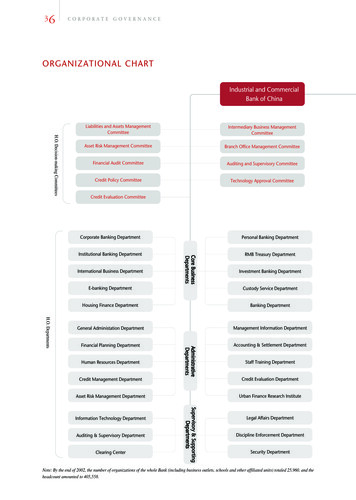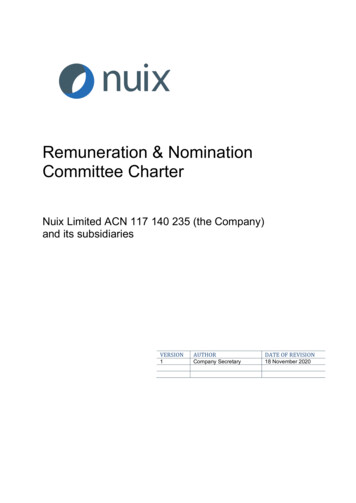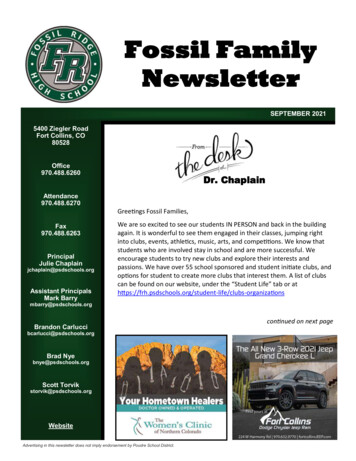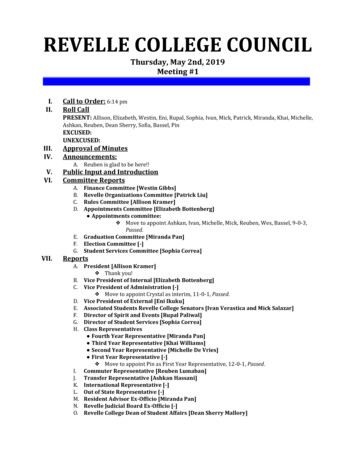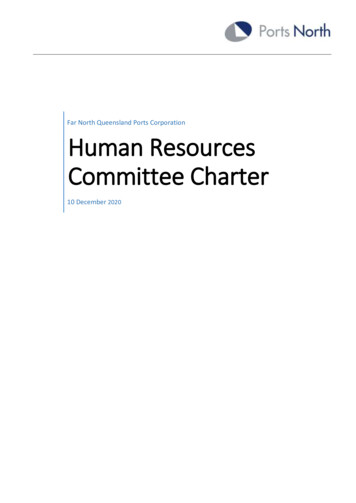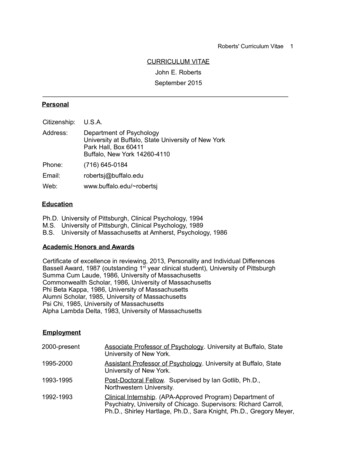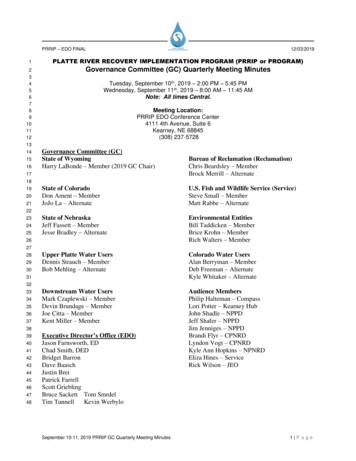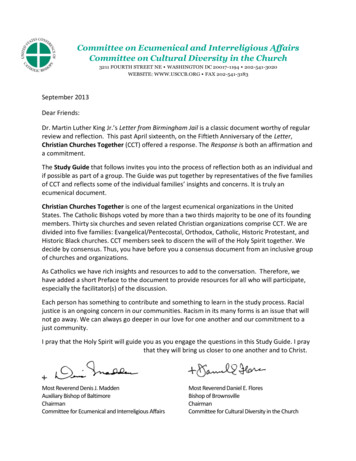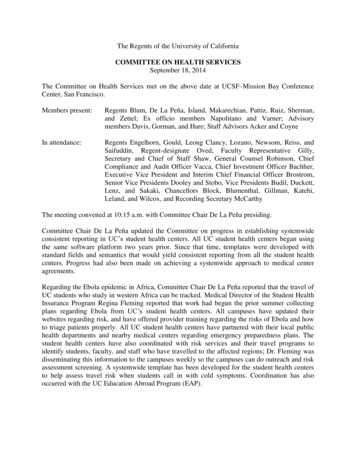
Transcription
The Regents of the University of CaliforniaCOMMITTEE ON HEALTH SERVICESSeptember 18, 2014The Committee on Health Services met on the above date at UCSF–Mission Bay ConferenceCenter, San Francisco.Members present:Regents Blum, De La Peña, Island, Makarechian, Pattiz, Ruiz, Sherman,and Zettel; Ex officio members Napolitano and Varner; Advisorymembers Davis, Gorman, and Hare; Staff Advisors Acker and CoyneIn attendance:Regents Engelhorn, Gould, Leong Clancy, Lozano, Newsom, Reiss, andSaifuddin, Regent-designate Oved, Faculty Representative Gilly,Secretary and Chief of Staff Shaw, General Counsel Robinson, ChiefCompliance and Audit Officer Vacca, Chief Investment Officer Bachher,Executive Vice President and Interim Chief Financial Officer Brostrom,Senior Vice Presidents Dooley and Stobo, Vice Presidents Budil, Duckett,Lenz, and Sakaki, Chancellors Block, Blumenthal, Gillman, Katehi,Leland, and Wilcox, and Recording Secretary McCarthyThe meeting convened at 10:15 a.m. with Committee Chair De La Peña presiding.Committee Chair De La Peña updated the Committee on progress in establishing systemwideconsistent reporting in UC’s student health centers. All UC student health centers began usingthe same software platform two years prior. Since that time, templates were developed withstandard fields and semantics that would yield consistent reporting from all the student healthcenters. Progress had also been made on achieving a systemwide approach to medical centeragreements.Regarding the Ebola epidemic in Africa, Committee Chair De La Peña reported that the travel ofUC students who study in western Africa can be tracked. Medical Director of the Student HealthInsurance Program Regina Fleming reported that work had begun the prior summer collectingplans regarding Ebola from UC’s student health centers. All campuses have updated theirwebsites regarding risk, and have offered provider training regarding the risks of Ebola and howto triage patients properly. All UC student health centers have partnered with their local publichealth departments and nearby medical centers regarding emergency preparedness plans. Thestudent health centers have also coordinated with risk services and their travel programs toidentify students, faculty, and staff who have travelled to the affected regions; Dr. Fleming wasdisseminating this information to the campuses weekly so the campuses can do outreach and riskassessment screening. A systemwide template has been developed for the student health centersto help assess travel risk when students call in with cold symptoms. Coordination has alsooccurred with the UC Education Abroad Program (EAP).
HEALTH SERVICES-2-September 18, 2014President Napolitano added that a number of UC physicians, nurses, and other staff wereinterested in responding to President Obama’s call for additional help with the Ebola epidemic inAfrica. A plan is being developed for the appropriate way UC can contribute.Regent Makarechian asked whether UC personnel were being prohibited from non-essentialtravel to areas in Africa affected by the Ebola epidemic. Dr. Fleming responded that her officehad coordinated with the UC Office of Risk Services and the EAP to communicate to studentsthat all travel to high-risk areas should be postponed. Committee Chair De La Peña reported thatChancellor Hawgood was developing guidelines for a program through which some UCprofessionals might assist with the Ebola outbreak.Committee Chair De La Peña stated that the meeting’s discussion items would include animportant presentation about the need for increased student mental health services whichdirectors of the student health centers had identified as their top priority.1.APPROVAL OF MINUTES OF PREVIOUS MEETINGUpon motion duly made and seconded, the minutes of the meeting of July 17, 2014 wereapproved.2.UCSF CLINICAL ENTERPRISE STRATEGIC PLANNING UPDATE[Background material was provided to Regents in advance of the meeting, and a copy ison file in the Office of the Secretary and Chief of Staff.]Senior Vice President Stobo said that UCSF Chief Executive Officer Mark Laret wouldprovide an update on UCSF’s clinical strategic plan. Chancellor Hawgood could notattend this meeting because he was in New York for the presentation of the prestigious2014 Lasker Basic Medical Research Award to UCSF chemist Peter Walter for his workon the important function of the folding and unfolding of proteins in cells. This awardexemplifies UCSF’s role as a national and international leader in academic programs andresearch. All four of UCSF’s health professional schools were ranked first among theirnational peers, an accomplishment Dr. Stobo called remarkable. UCSF’s clinical programwas ranked in the top ten in the nation by U.S. News and World Report. The success ofUCSF’s clinical program is important because its revenue provides the capital necessaryto support its outstanding clinical care and also provides 100 million annually to supportUCSF’s academic enterprise. UCSF’s clinical enterprise cannot continue to thrivewithout a strategic plan.Mr. Laret expressed UCSF’s strong support for the recent selection of ChancellorHawgood. UCSF has a storied history of innovation in diagnosing illnesses and treatingpatients. In the last decade UCSF had focused on achieving the safest and highest qualitydelivery of care. Dramatic improvements had been made in reducing hospital-acquiredconditions, such as pressure ulcers and deaths from sepsis. In addition, UCSF’s entirestaff had focused on improving its patients’ experience. As a result of its strong financialperformance over the past decade, UCSF had been able to invest more than 1 billion in
HEALTH SERVICES-3-September 18, 2014renewal and replacement of aging facilities and equipment at its locations other thanMission Bay, and another 500 million in support of its academic enterprise, making upfor reduced State support.UCSF’s most significant project of the past decade was its purchase of land in MissionBay and the building of a new 1.5 billion 289-bed women’s, children’s, and cancerhospital. The new hospital was developed to meet seismic requirements, upgrade UCSF’sfacilities, and expand its capacity for services at its other campuses. Mr. Laret reportedthat the new Mission Bay Hospital had received its Certificate of Occupancy from theState. The hospital was being stocked and staff was being trained for opening onFebruary 1, 2015. The new hospital was completed eight days ahead of schedule and 30 million below budget. Mr. Laret said the hospital was made possible by thegenerosity of the local community; the hospital currently had pledges for more than 511 million of its 600 million fundraising goal.UCSF’s strategic planning process began two-and-a-half years prior and involvedanticipated lower payments from Medicare, Medi-Cal, and commercial insurancecompanies, and the Patient Protection and Affordable Care Act’s (PPACA) desiredbusiness model of managing the health of a population. The planning process arrived atthree strategies. The first strategy was developing destination programs, building onUCSF’s longstanding position as a leader in providing highly specialized care. The needwould remain for this type of care, including organ transplants, care for patients withbrain tumors or neurodegenerative diseases, cancer, advanced cardiovascular disease, andcomplex children’s services. Patients travel long distances to receive these services atUCSF. Kaiser Permanente currently contracts with UCSF to perform kidney and livertransplants and certain other services for Kaiser patients. While UCSF also providesprimary and secondary care, these specialty services disproportionately drive UCSF’sfinancial performance. In this area, UCSF’s strategy is to increase capacity and make iteasier for health plans like Kaiser to contract with UCSF. UCSF Benioff Children’sHospital’s affiliation with Children’s Hospital Oakland was part of this strategy and hadalready yielded cost savings to make UCSF’s service more price competitive. Integratedclinical services have been developed in orthopedics, dermatology, and head and necksurgery. Marc and Lynne Benioff recently made an additional 100 million gift to UCSFBenioff Children’s Hospital, half of which was designated for use at the Children’sHospital Oakland site. The newly named UCSF Benioff Children’s Hospitals in Oaklandand San Francisco are examples of programs the campus hoped to replicate in theupcoming few years.Mr. Laret stated that, like most academic medical centers, UCSF was a high-quality butalso high-cost medical services provider. However, in the current healthcare environmentbuyers of healthcare services, including the government, companies, and privateindividuals, want high-quality, but low-cost services, and were often willing tocompromise quality for cost. UCSF’s second strategy focuses on developing a culture ofcontinuous process improvement with appropriate, but frugal, use of resources. Valuestream mapping exercises had demonstrated ample waste that could be removed fromalmost every process. Eliminating wasteful, time-consuming processes would benefit
HEALTH SERVICES-4-September 18, 2014patients and those who pay for their care. UCSF’s immediate goal was to reduce its basicoperating costs in the current year by 28 million as part of the systemwide leveragingscale for value initiative to reduce UC Health’s systemwide costs by 50 million.UCSF’s third strategy was to build an accountable care organization (ACO) to managethe health of populations. The campus had some experience through its partnering withhealth plans such as Blue Shield and Health Net; UCSF was managing the totalhealthcare cost for a portion of the City and the County of San Francisco employees andUCSF’s Blue and Gold Health Net employees. These plans were incentivized to keeppatients well and out of the hospital, the centerpiece of the business model of thePPACA. The prior year UCSF convened 16 of the most highly regarded hospitals andphysician organizations in the Bay Area to test their interest in participating in a boldexperiment in accountable care: coming together as independent organization to build anew healthcare delivery system across the Bay Area with common clinical protocols,integrated information technology systems, and an overriding philosophy that patientsshould be kept healthy. After a year of hard work, UCSF now had a committed group oforganizations prepared to take on this challenge. UCSF hoped to offer a new ACO to BayArea businesses in January 2016. In the development of this business plan, UCSF workedmost closely with John Muir Health, the highest ranked community hospital in the region.The leadership and board of John Muir Health wanted to form a new company withUCSF to capitalize the new ACO and begin collaboration on several other initiatives.Mr. Laret remarked that UCSF Health was growing, with current revenues of nearly 3 billion, and was comprised of the adult UCSF Medical Center, UCSF BenioffChildren’s Hospitals in Oakland and San Francisco, BayChildren’s Physicians, which is ajoint venture with Benioff Children’s Hospital Oakland, the UCSF Faculty GroupPractice, and the Langley Porter Psychiatric Hospital and Clinics. The prior year, thenDean Hawgood and Mr. Laret reviewed UCSF Health’s organizational structure with thegoal of redesigning it around three objectives: first, to have decision-making processes befar less bureaucratic and to ensure that strategic choices were being made with the bestinterest of the entire UCSF system in mind; second, to strengthen UCSF Health’sleadership team to take on the magnitude and complexity of challenges currently faced inthe healthcare marketplace and to ensure continuity; and third, to achieve cost savings byeliminating duplicate functions across the enterprise wherever possible. A neworganizational structure had been established that the campus believes would meet all ofthese objectives. Some personnel searches were underway, with more to follow in thenear future, with the goal of filling as many positions as possible from within theorganization to create a more robust career ladder. In addition, new senior-level talentwould be recruited from outside the organization. Mr. Laret expressed confidence thatUCSF Health was well-positioned to face the healthcare environment for the comingdecades.Dr. Stobo added that the ability of UCSF’s clinical enterprise to achieve these goals wasbased entirely on revenue from its clinical services. No State general funds support UCSFMedical Center. Further detail on the ACO with John Muir and UCSF’s Long RangeDevelopment Plan would be provided at a future meeting.
HEALTH SERVICES-5-September 18, 2014Committee Chair De La Peña stated that one challenge would be to balance individualmedical centers’ desires to function in their own areas of expertise and to take advantageof opportunities to create local ACOs, with their functioning as part of the systemwideUC Health. Mr. Laret agreed that no individual market agreements should compromisesystemwide goals. On the other hand, UC medical centers’ positions in their localmarkets should be strengthened to add to UC’s systemwide strength.Regent Zettel commented that a symposium on transplantation hosted and organized byUCSF the prior week focused on patient care and safety, improving clinical practice, andhighlighting new technologies to ensure that every organ donation is successfullytransplanted. She highlighted the extent of the need for organ donation, with22,000 Californians currently waiting for organs to be donated, 84 percent of whom arewaiting for kidneys. Regent Zettel thanked Mr. Laret for UCSF’s making transplantationa priority. Mr. Laret added that UCSF had the longest waiting list in the nation for kidneytransplants and donation is critical to meeting this need.Regent Gould expressed appreciation for UCSF’s work in developing ways to adapt tothe changing healthcare environment created by the PPACA. He asked whether thesetypes of partnerships with other healthcare organizations would be expanded to achievethe necessary scale. Mr. Laret responded that this emerging strategy was a response to themarket reality. Smaller hospitals faced with insufficient patient base to support theirservices were searching for partnerships with larger hospitals like UCSF; UCSF neededthese partnerships to establish a network with sufficient patient base. He envisioned BayArea healthcare five to ten years hence having two or three large healthcare systems andexpressed hope that UCSF would be central to one of them.Regent Gould asked Dr. Stobo whether he saw this as the path forward for all of UC’smedical centers. Dr. Stobo confirmed that the general strategy was for each UC medicalcenter to take initiative to survive and thrive in its local market, in addition to thesystemwide strategy to take advantage of the scale of UC Health. The challenge would beto ensure that local collaborations do not have a negative effect on systemwide efforts,and that UC Health’s systemwide efforts do not impede individual medical centers’entrepreneurial strategies.Regent Ruiz expressed support for UCSF’s strategic plans, but asked whether there mightbe a conflict between being a provider of both high-quality, high-cost specializedprocedures and low-cost, efficient services. Mr. Laret agreed that it would be difficult tofocus on UCSF’s historical strength in destination programs, which are specialized, highcost, tertiary care programs, and also focus on population health management at thelowest possible cost. However, the reality of the healthcare environment dictated thatUCSF had a responsibility to excel in both types of services. Should the ACO with JohnMuir Hospital succeed, it would become a very attractive affiliation for other hospitalsand medical groups in the area. UCSF could be in the position of benefiting financiallywhen a patient went to the most efficient healthcare provider, not necessarily UCSF, butpart of UCSF’s ACO. He agreed that succeeding in this environment over the upcomingyears would be extremely challenging.
HEALTH SERVICES-6-September 18, 2014Regent Makarechian noted the significance of UCSF’s building the new Mission Bayhospital on time and on budget, particularly given the complexities of hospitalconstruction.Regent Blum observed that UCSF was of far higher quality than any other hospital in thearea. Having other hospital systems, such as Kaiser Permanente, refer patients to UCSFfor specialty care that Kaiser cannot provide was a clear-cut referral. He cautioned that itwould be important in any new ACO affiliations not to have an affiliate hospital of lesserquality deliver care and use UCSF’s name. Mr. Laret agreed.3.BRIEFING ON PROPOSITION 46: MEDICAL MALPRACTICE LAWSUIT CAPAND DRUG TESTING OF DOCTORS INITIATIVE[Background material was provided to Regents in advance of the meeting, and a copy ison file in the Office of the Secretary and Chief of Staff.]Senior Vice President Stobo informed the Committee that Proposition 46 had threeprovisions. First, to increase the cap on recovery for pain and suffering in medicalmalpractice lawsuits from 250,000 to 1.1 million, on both future and pending cases.UC’s Office of the General Counsel estimated the current financial implications of thisprovision to the University to be 6 million to 21 million. Passage would also result inincreased interest from plaintiffs’ attorneys in filing medical malpractice claims thatwould have a further effect on the University.Proposition 46’s second provision involved routine and for-cause drug testing ofphysicians. Many details of this provision have not yet been provided so the financialeffect on the University cannot be clearly determined. The third provision, intended toreduce drug abuse, would require use of a database yet to be developed prior toprescribing Schedule 2 and Schedule 3 drugs.4.UC HEALTH UPDATE:HEALTH SERVICESINCREASED STUDENT ACCESS TO MENTAL[Background material was provided to Regents in advance of the meeting, and a copy ison file in the Office of the Secretary and Chief of Staff.]Senior Vice President Stobo stated that the need for student mental health services wasoutstripping the campuses’ ability to provide those services. The campuses wereattempting to provide services using existing resources. Dr. Stobo introduced MedicalDirector of the UC Student Health Insurance Program (UC SHIP) Regina Fleming andExecutive Director of UCLA Counseling and Psychological Services Elizabeth GongGuy to present information about this problem, which was a national issue. Dr. Stobostated that he would return to the Committee at a future meeting with proposed solutions.Dr. Fleming stated that access to mental health care on college campuses had been aconcern for several years and was also the subject of the 2006 Report of the University ofCalifornia Student Mental Health Committee (Report). As a result of that report,
HEALTH SERVICES-7-September 18, 2014 12 million was allocated to UC’s student health and counseling centers. However, thatamount was less than one-third of the 43 million that had been recommended by theStudent Mental Health Committee, and the allocation had been subsequently reducedfurther by budget cuts between 2009 and 2010. The student counseling centers werefortunate to receive 6.8 million in grant funding related to Proposition 63. Thistemporary funding was helpful in allowing hiring of additional staff to increase screeningand outreach. This funding would come to an end in the current year.The pattern of increased demand had continued unabated since 2006 and had impeded thecampuses’ ability to provide for UC students’ health and well-being, which is essential totheir academic success. Dr. Fleming stated that Dr. Stobo had asked her the prior springto review mental health service patterns on UC campuses. While she was conducting thatreview, the shootings in Isla Vista of UC Santa Barbara students occurred, tragicallybringing this issue to the forefront.Three issues became apparent in the review of the status of student mental health care atUC. First, students were in fact having difficulty accessing mental health services.Students must wait longer for appointments; they have fewer appointments in the courseof therapy; and more students need to be referred off campus. Off-campus referrals wereproblematic, because about half of students referred off campus did not follow up on thecare, with an even lower rate of follow-up among students of color.Dr. Fleming stated that the second issue revealed in her review was that care needed to bereconceptualized in order to make the best use of campuses’ available resources. Theskills of psychology and psychiatry staff needed to be supplemented by expanding theuse of other types of caregivers such as case managers, social workers, primary carephysicians, and nurse practitioners. Other innovative strategies such as telehealth deliveryof mental health services should be considered. Third, additional resources were neededto ensure the success of the mission of supporting UC students so they can be successfulacademically.Ms. Gong-Guy provided information about larger patterns in student mental health.Across the nation, colleges have reported steadily increasing numbers of students whoseemotional distress and mental health complaints have impaired their academicfunctioning. In highly competitive universities, such as UC, the effects of compromisedmental health were even more pronounced. An anxious student who has difficultyfocusing can fall into a pattern of procrastination and avoidance that, if left unchecked,can develop into a spiraling depression. Self-medication with alcohol or other substancescan result in more debilitating anxiety, hopelessness, and even suicidal thoughts. If thisstudent cannot access counseling to reverse this spiral, the despair could become lifeendangering.Many of UC’s most talented students have characteristics that leave them vulnerable tothe stress and pressure of the University. Most UC students had outstanding recordsbefore college, and many had never experienced a previous academic setback.Increasingly, many students who seek help at UC student counseling centers are
HEALTH SERVICES-8-September 18, 2014perfectionists who have driven themselves with very little sense of balance or selfcompassion. These students can have eating disorders, crippling obsessive-compulsivedisorders, histories of cutting themselves, addictions, and illicit stimulant abuse.Ms. Gong-Guy displayed a chart showing national increases during the past three years inthe percentages of students in counseling who report serious suicidal ideations, suicideattempts, self-injury, serious homicidal ideation, and incidents of violence.Ms. Gong-Guy discussed the effects of this national pattern on UC students. Generally allUC students know a fellow student with a serious emotional illness. For UC faculty, thesetrends can mean engaging UC student crisis teams when a student explodes in anger atclassmates. The effect of students’ emotional crises are profound across UC campusesand throughout the living and learning community. Students and faculty are increasinglyaware of students’ mental health concerns.The three-year Proposition 63 funding for the student mental health initiative aidedmental health stigma reduction efforts across UC campuses, enabling UC’s counselingcenters to work with student peers to raise suicide prevention awareness, increase earlyidentification of at-risk students, and reduce mental health stigma. These efforts naturallyled to an increased utilization of student counseling centers. Proposition 63 funds alsoenabled counseling centers to increase direct student services. However, the funding fromProposition 63 was expiring. Ms. Gong-Guy displayed a chart showing the increasedutilization of UC student counseling centers in each year since the 2006 Report, and a37 percent increase from 2007 to 2013. The 2014 data were even more startling: UCLA’sstudent counseling center reported a single year 23 percent increase in 2014; it treated8,500 students the prior year, 21 percent of UCLA’s student population. While thisincrease was alarming, early intervention and access to services could alter the emotionalhealth trajectory of many of these students.Dr. Fleming pointed out that UC students seek mental health care from campuscounseling and psychological services; many also come to student health centers for care.In the past three years, there had been a 20 percent increase in the number of studentswho self-identified as seeking care from UC student health centers for anxiety ordepression. Many other students come to the student health centers with complaints ofphysical symptoms such as insomnia, weight loss, or difficulty sleeping. Students werecoming to campus with more severe pre-existing mental health issues, as evidenced bythe large numbers of students taking psychiatric medications. According to informationgathered by UC’s counseling centers, 25 percent of students who utilized UC counselingand psychological services were taking psychotropic medications at the time ofpresentation. Data from insurance claims of students covered by UC SHIP show that thecombined medications for attention deficit hyperactivity disorder and antidepressantsaccount for the greatest number of prescriptions filled.Ms. Gong-Guy discussed wait times for student mental health services in connection withthe academic calendar. She cited the example of a mildly anxious procrastinating studentwho recognized that he needed help in week three of the academic quarter. A non-urgentintake appointment at the student counseling center would be scheduled in ten working
HEALTH SERVICES-9-September 18, 2014days, or week five of the quarter. If the intake counsellor found no urgent risk, the firstfollow-up appointment would be scheduled in four weeks, or week ten of the quarter. Thestudent who sought help in week three, finally would begin treatment in week ten, rightbefore finals week. A routine procrastination intervention could have developed into afull-blown academic crisis. The student counseling centers offer outstanding care andoperate best for early intervention and crisis prevention care. However, the increasedstudent utilization had seriously limited access to timely treatment that was needed tosupport students’ success.Dr. Fleming summarized that the campus counseling and student health centers haveimplemented several strategies to ensure that students with urgent needs are seen andcared for in a timely manner. Despite these efforts, student are having increasingdifficulty accessing services both on and off campus. Additional resources are needed tofund efforts to increase the availability of coordinated on-campus care necessary to helpstudents reach their full academic potential.Committee Chair De La Peña stated that this matter was of such importance that itdeserved a full discussion of available options at a future meeting. He asked Dr. Stobo toreturn to the Committee with potential solutions and information about how UCcompared in this area with other universities.Regent Makarechian asked that information in this presentation be forwarded to theRegents.The meeting adjourned at 11:20 a.m.Attest:Secretary and Chief of Staff
Hospital Oakland site. The newly named UCSF Benioff Children's Hospitals in Oakland and San Francisco are examples of programs the campus hoped to replicate in the upcoming few years. Mr. Laret stated that, like most academic medical centers, UCSF was a high-quality but also high-cost medical services provider.
